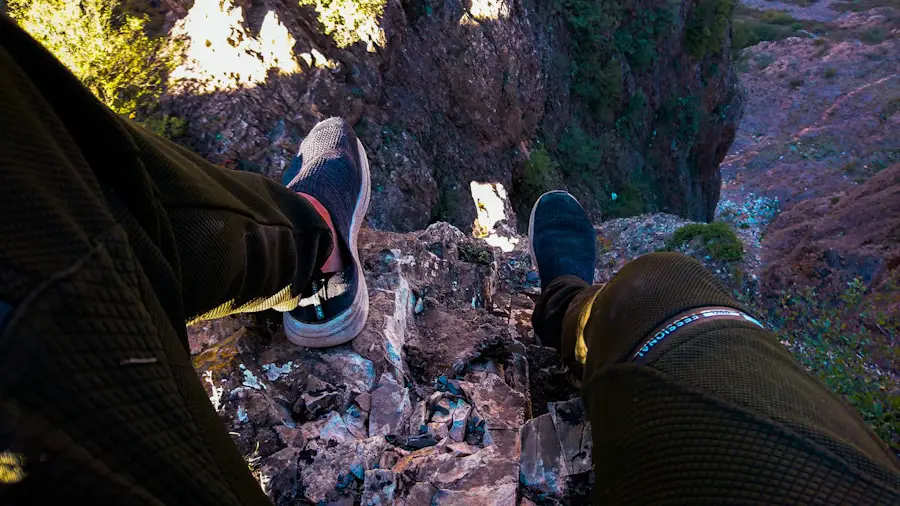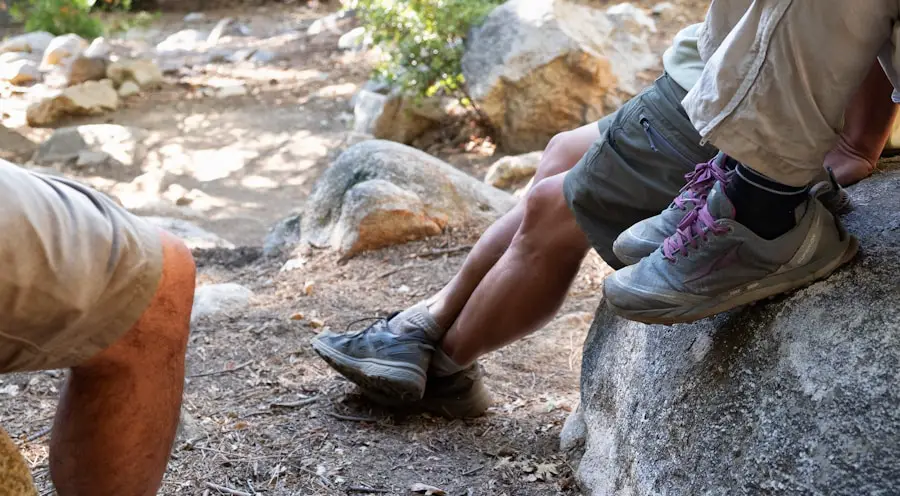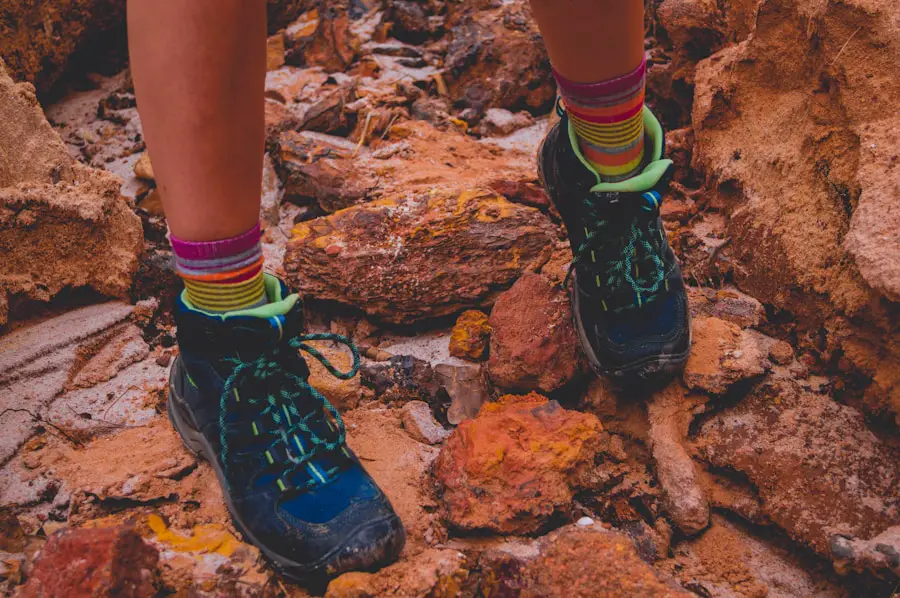When embarking on a hiking adventure, the significance of proper footwear cannot be overstated. While many hikers focus on selecting the right boots or shoes, the choice of socks is equally crucial. Hiking socks serve as the first line of defense against the elements, providing comfort, support, and protection for your feet.
Unlike regular cotton socks, which can lead to blisters and discomfort, hiking socks are specifically designed to meet the demands of outdoor activities. They are engineered to wick moisture, provide cushioning, and offer support where it is needed most. The right pair of hiking socks can enhance your overall hiking experience.
They help to regulate temperature, manage moisture, and reduce the risk of injuries such as blisters and hotspots. A well-fitted, high-quality sock can make a significant difference in how your feet feel after a long day on the trail. Understanding the basics of hiking socks is essential for any outdoor enthusiast, as it lays the foundation for making informed choices that will contribute to a more enjoyable and successful hike.
Key Takeaways
- Proper footwear, including hiking socks, is crucial for a comfortable and enjoyable hiking experience.
- Wool, synthetic, and blended materials each have their own benefits, so choose based on your specific needs and preferences.
- Hiking socks with cushioning and support can help prevent blisters and hotspots, enhancing overall comfort.
- Moisture management is essential for keeping feet dry and comfortable during long hikes.
- Quality hiking socks offer durability and longevity, making them a worthwhile investment for avid hikers.
Choosing the Right Material: Wool, Synthetic, or a Blend?
The material of your hiking socks plays a pivotal role in their performance and comfort. Wool has long been a favorite among hikers due to its natural properties. Merino wool, in particular, is prized for its softness, moisture-wicking capabilities, and temperature-regulating qualities.
Unlike traditional wool, which can be itchy and uncomfortable, Merino wool is fine and soft against the skin. It can absorb moisture without feeling wet, keeping your feet dry even during strenuous hikes. Additionally, wool has natural antimicrobial properties that help reduce odor, making it an excellent choice for multi-day treks.
On the other hand, synthetic materials such as polyester and nylon offer their own set of advantages. These materials are often lighter and dry faster than wool, making them ideal for warm-weather hikes or situations where quick drying is essential. Synthetic fibers are also more durable than natural fibers, which can be beneficial for rugged terrains.
Many modern hiking socks utilize a blend of both wool and synthetic materials to capitalize on the strengths of each. This combination can provide the best of both worlds: the comfort and moisture management of wool with the durability and quick-drying properties of synthetics.
Cushioning and Support: How Hiking Socks Can Prevent Blisters and Hotspots

Cushioning is another critical factor to consider when selecting hiking socks. The right amount of cushioning can significantly impact your comfort level on the trail. Hiking socks come in various thicknesses, from ultra-light to heavy-weight options.
Thicker socks often provide more cushioning, which can be beneficial for long hikes or when carrying a heavy pack. This cushioning acts as a buffer between your foot and the shoe, reducing friction and helping to prevent blisters and hotspots. Support is equally important in hiking socks.
Many models feature arch support and reinforced areas around the heel and toe to provide additional stability. This support helps to keep your foot properly aligned within your boot, reducing fatigue over long distances. For those who are prone to blisters or have specific foot conditions, choosing socks with targeted cushioning in high-friction areas can be particularly advantageous.
By investing in socks that offer both cushioning and support, hikers can enjoy longer treks with less discomfort.
Moisture Management: Keeping Your Feet Dry and Comfortable
| Moisture Management | Benefits |
|---|---|
| Wicking Technology | Keeps feet dry by drawing moisture away from the skin |
| Breathable Materials | Allows air to circulate, reducing sweat and odor |
| Antimicrobial Properties | Prevents bacteria growth and keeps feet fresh |
| Quick Drying | Ensures fast evaporation of sweat and water |
Moisture management is a fundamental aspect of hiking sock design. When hiking, your feet are likely to sweat, especially during strenuous climbs or in warm weather. If moisture is trapped against your skin, it can lead to blisters and discomfort.
High-quality hiking socks are designed with moisture-wicking properties that draw sweat away from your feet and allow it to evaporate quickly. This feature is crucial for maintaining comfort during long hikes. In addition to wicking moisture away from the skin, some hiking socks incorporate mesh panels or ventilation zones to enhance breathability.
These design elements allow for better airflow around the foot, further aiding in moisture management. For those who hike in wet conditions or during rainy seasons, waterproof or water-resistant socks may also be an option worth considering. These specialized socks can help keep your feet dry even when traversing through puddles or wet grass.
Temperature Regulation: Insulating Your Feet in Cold Weather and Keeping Them Cool in the Heat
Temperature regulation is another vital function of hiking socks that often goes unnoticed until it becomes an issue on the trail. In cold weather conditions, insulating properties are essential to keep your feet warm without overheating. Wool is particularly effective at trapping heat while still allowing moisture to escape, making it an excellent choice for winter hikes or colder climates.
Some hiking socks are designed with additional insulation layers or thicker materials specifically for cold-weather use. Conversely, during hot weather hikes, it’s crucial to keep your feet cool to prevent overheating and excessive sweating. Lightweight synthetic materials excel in this regard by providing breathability and quick-drying capabilities.
Many summer hiking socks feature mesh zones that enhance airflow around the foot, helping to regulate temperature effectively. By choosing socks designed for specific weather conditions, hikers can ensure their feet remain comfortable regardless of the season.
Durability and Longevity: Investing in Quality Hiking Socks

When it comes to hiking gear, durability is a key consideration that should not be overlooked. Hiking socks endure significant wear and tear due to friction from boots and exposure to various terrains. Investing in high-quality socks made from durable materials can save you money in the long run by reducing the frequency of replacements.
Look for socks reinforced in high-wear areas such as the heel and toe; these reinforcements help extend the life of the sock. Moreover, reputable brands often conduct rigorous testing on their products to ensure they can withstand the rigors of outdoor activities. While it may be tempting to opt for cheaper options, lower-quality socks may not provide the necessary support or comfort over time.
By prioritizing durability when selecting hiking socks, you can enjoy countless adventures without worrying about premature wear or performance issues.
Proper Fit: Avoiding Bunching, Slipping, and Chafing
The fit of your hiking socks is paramount to ensuring comfort on the trail. A sock that is too loose may bunch up inside your boot, leading to friction points that can cause blisters. Conversely, a sock that is too tight can restrict circulation and create discomfort during long hikes.
It’s essential to choose socks that fit snugly without being constrictive; this balance will help prevent slipping and chafing. Many brands offer sizing charts that take into account both shoe size and sock size; utilizing these charts can help you find the perfect fit for your feet. Additionally, some hiking socks come with specific features such as arch support bands or graduated compression that enhance fit and comfort further.
By paying attention to fit details when selecting hiking socks, you can significantly reduce the risk of foot-related issues during your outdoor excursions.
Hiking Socks for Different Types of Terrain: Matching Your Socks to Your Adventure
Different types of terrain require different considerations when it comes to selecting hiking socks. For instance, if you’re planning a trek through rocky or uneven terrain, thicker cushioned socks may be beneficial for added protection against impacts and abrasions. On the other hand, if you’re heading out on a flat trail or a day hike in warm weather, lightweight socks with good breathability may be more appropriate.
For those who frequently hike in wet conditions or muddy environments, waterproof or water-resistant socks can provide an extra layer of protection against moisture intrusion while still allowing for breathability. In contrast, if you’re venturing into snowy landscapes or cold climates, insulated wool socks will help keep your feet warm while managing moisture effectively. By matching your sock choice to the specific demands of your adventure, you can enhance both comfort and performance on the trail.
In summary, understanding the various aspects of hiking socks—from material selection to fit—can significantly impact your overall hiking experience. By investing time in choosing the right pair tailored to your needs and terrain type, you set yourself up for success on every hike you undertake.
If you’re planning a hiking trip, you’ll want to make sure you have the right gear, including a good pair of hiking socks. These socks are designed to provide cushioning, support, and moisture-wicking properties to keep your feet comfortable and dry on the trail. For more travel gear recommendations, check out this article on the 5 Must-Have Minimalist Travel Backpacks for Spring Adventures 2025.
Love travel? Join Our Facebook Community For More Tips.
FAQs
What are hiking socks?
Hiking socks are specially designed socks that are worn during hiking or trekking activities. They are designed to provide comfort, support, and protection for the feet during long walks or hikes in various terrains.
What are the features of hiking socks?
Hiking socks typically have features such as cushioning, moisture-wicking properties, arch support, and reinforced heel and toe areas. They are often made from materials like merino wool, synthetic blends, or a combination of both to provide warmth, breathability, and durability.
Why are hiking socks important?
Hiking socks are important because they help prevent blisters, provide cushioning and support for the feet, and help regulate temperature and moisture. They can also improve overall comfort and reduce the risk of foot-related injuries during long hikes.
How do hiking socks differ from regular socks?
Hiking socks are designed to be thicker and more durable than regular socks. They often have additional padding in specific areas, such as the heel and toe, and are made from materials that are better at managing moisture and regulating temperature.
What should I look for when choosing hiking socks?
When choosing hiking socks, it’s important to consider factors such as the material, cushioning, fit, and intended use. Look for socks that provide the right level of cushioning and support for your hiking activities and that are made from moisture-wicking materials to keep your feet dry and comfortable.
